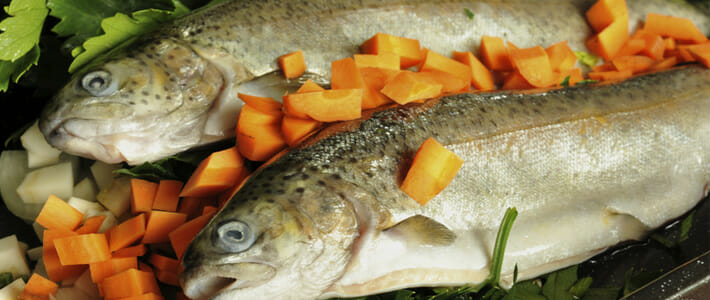Trout

Trout belong to the salmon family. Trout is the name for a number of species of freshwater and saltwater fish. Trout are classified as an oily fish. Trout that live in different environments can have dramatically different colorations and patterns. Mostly, these colors and patterns form as camouflage based on the surroundings and will change as the fish moves to different habitats. Trout in or newly returned from the sea can look very silvery, while the same fish living in a small stream or an alpine lake could have pronounced markings and more vivid coloration.
Product pdf for download-
3 oz. (79g) raw edible portion
-
Calories 117
-
Calories from fat 47
-
Total Fat 5g
-
Saturated Fat 1g
-
Cholesterol 46mg
-
Sodium 41mg
-
Carbohydrates 0g
-
Protein 16g
-
Potassium 0mg
Species
The Atlantic species include Adriatic Trout, Brown Trout, Flathead Trout, Marble Trout, Ohrid Trout, Sevan Trout and Sea Trout. The Pacific species include the Apache Trout, Biwa Trout, Butthroat Trout, Gila Trout, Golden Trout, Rainbow Trout, and Mexican Golden Trout. The Char species of trout include Aurora Trout, Brook Trout, Bull Trout, Dolly Varden Trout, Lake Trout, and Silver Trout.
Interesting Fact
Trout have always been favorite fish with anglers, and on the worldwide and national level more money has been expended on their propagation than any other fish species. Rainbow Trout is recommended as a “Best Choice” on many seafood watch lists and is listed on the exclusive “Super Green List” of the Monterey Bay Aquarium Seafood Watch program.
Alternatives
Other trout or salmon.
Source
Trout are usually found in cool (50–60 °F, 10–16 °C), clear streams and lakes. At Fruge’s, we use farm raised “green” fish to maintain the balance of sustainablity. Effluent water from farms and processing plants are under strict National Pollutant Discharge Elimination System (NPDES) permits for each farm and facility and is monitored by the Idaho Department of Environmental Quality (DEQ) and EPA. Furthermore, company effluent standards are more stringent than state or federal requirements.
Harvest Method
Trout are raised in concrete raceways fed by an abundance of spring water. A patented, automated feed system distributes feed to the fish throughout the day. Production farms are continually monitored and inventoried to provide highly accurate production forecasts. The rainbow trout are pumped out of the raceways during harvest.
Flavor
Tasty no matter how it is prepared, freshwater trout is a delicately flavored ruby red or white-meat fish whose pure flavors are complemented by even the simplest preparations. The difference between white and ruby trout is only skin deep. Trout farms achieve “ruby-ness” by feeding the fish natural color enhancers; color does not affect taste.
Texture
Firm-textured flesh with a medium to high fat content.
Preparation
Trout is good baked, broiled, grilled, poached, pan-fried, or deep-fried.
Trout do not need to be scaled. Removal of the tiny scales also removes the thin coat of natural jelly around the scales that allows the trout to be breaded without using any type of liquid. Use mild-flavored oils because off-flavors in fats can be transferred to the taste of the trout. Best fats include butter, hydrogenated shortening, or peanut or corn oils. Trout is best fried hot and quickly; trout fried at a low temperature absorbs too much fat. The best temperature is 325 to 350F. Make sure to not overcook trout; it should be moist and fork-tender. Overcooking dries out and toughens the fish. Trout is done when it flakes easily when probed with a fork.
Quality Control
Fresh trout should be glistening, flawless, and clean smelling. The flesh should be firm and spring back when pressed.
Market Segments
This fish is appropriate in the casual dining, fine dining, hotel, and resort/club segments of the market.